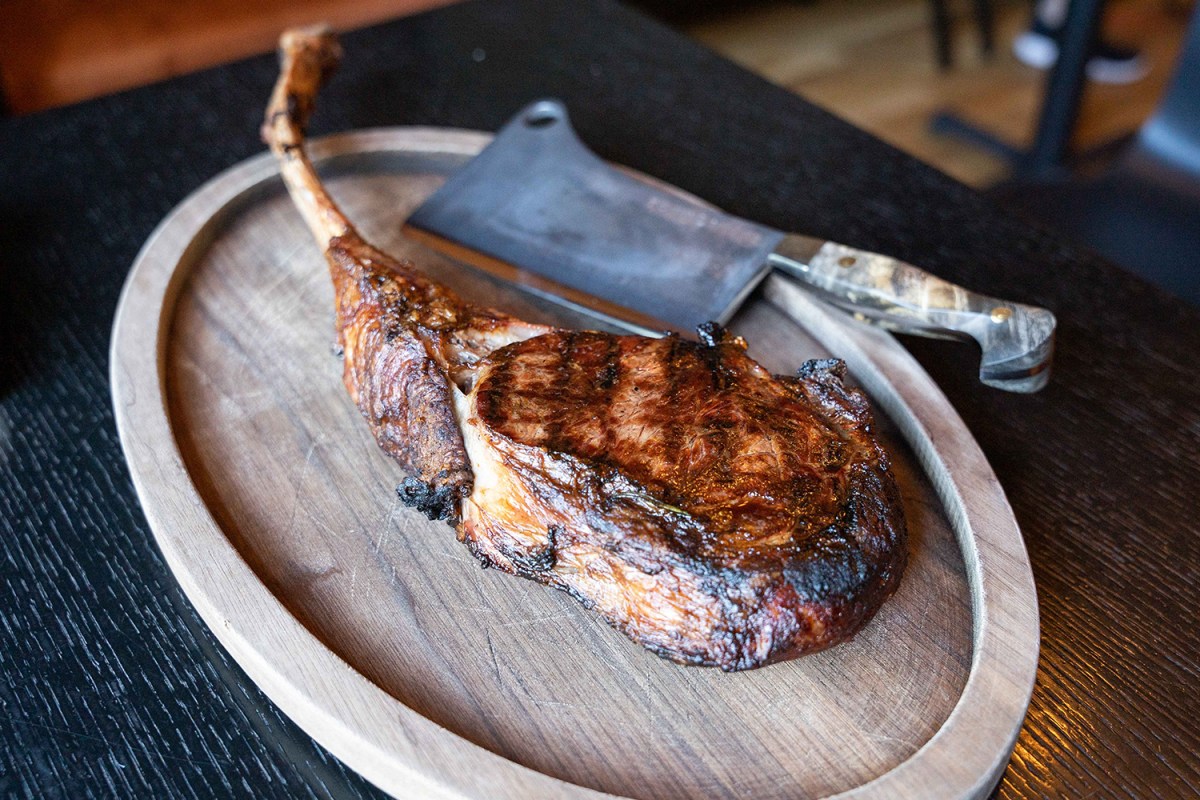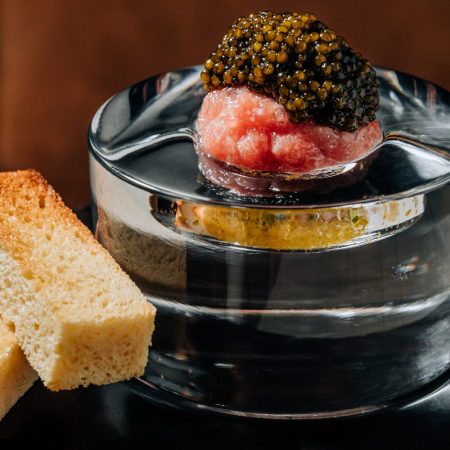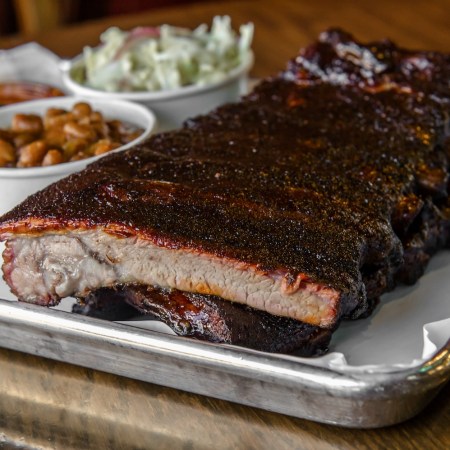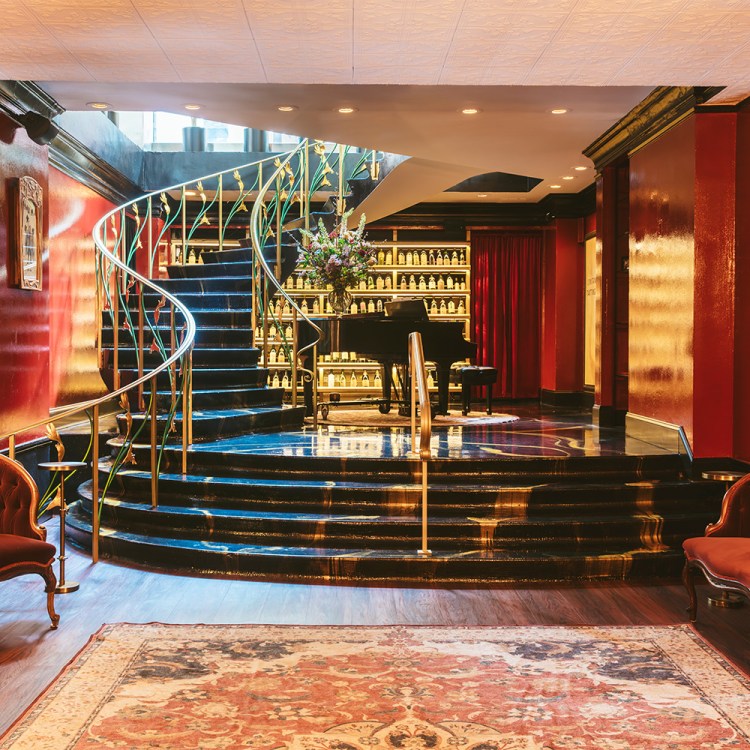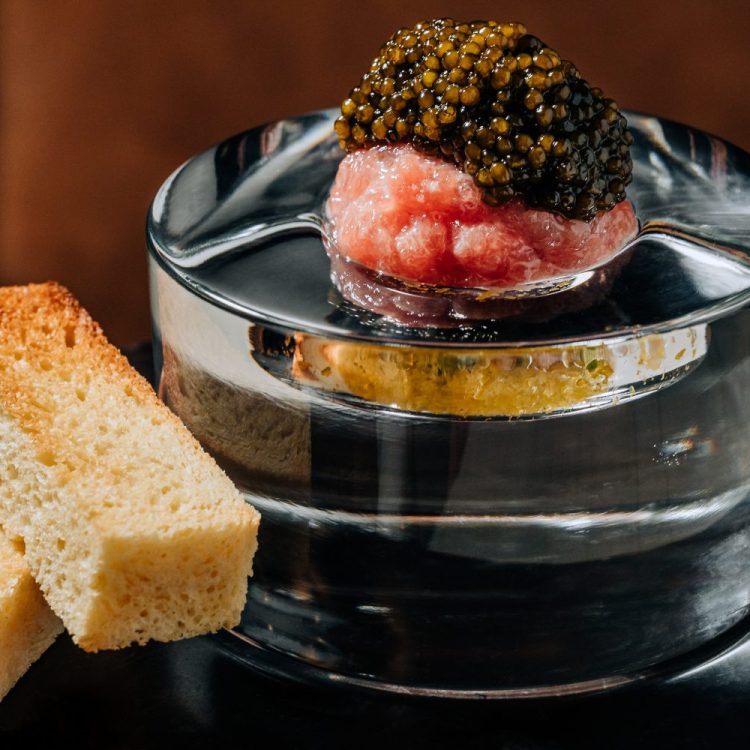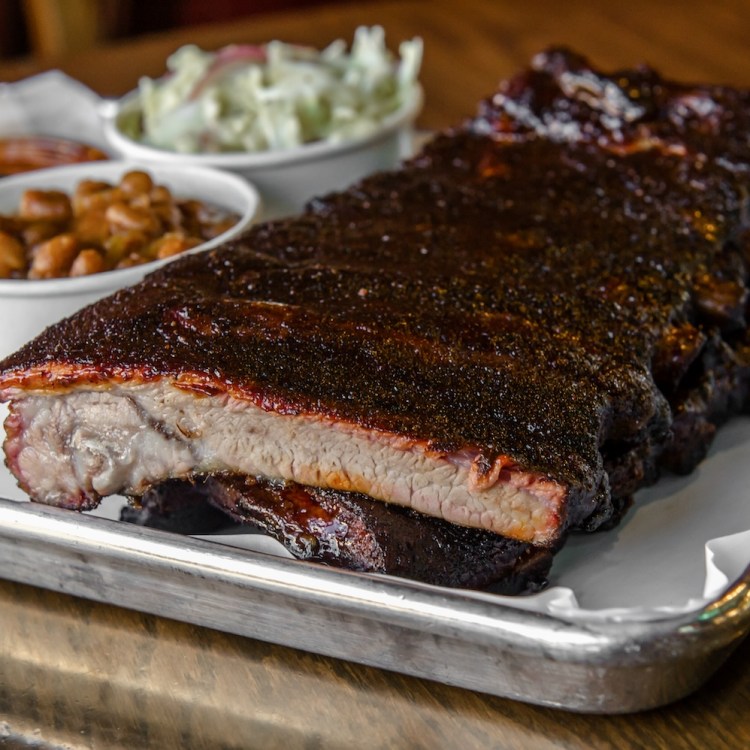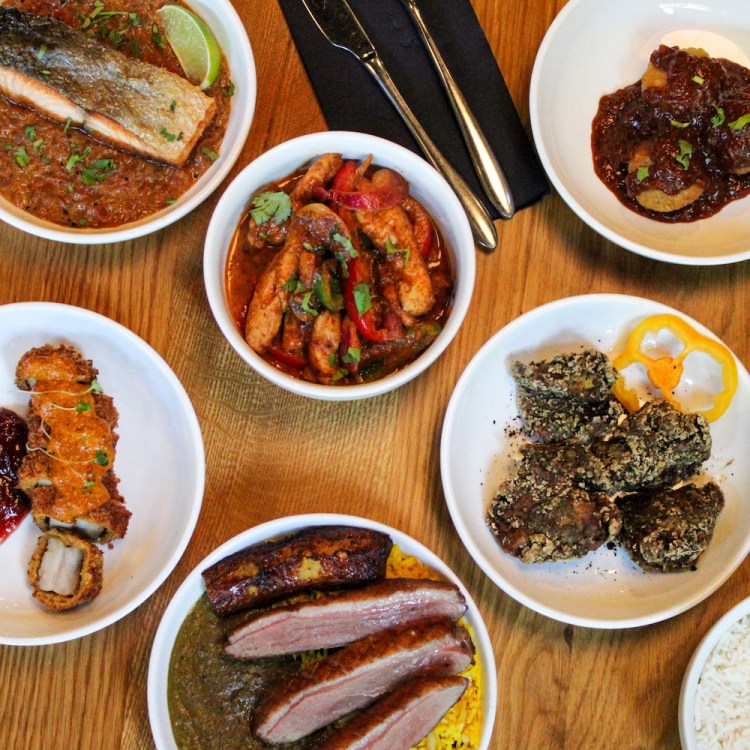You’re already a master griller, a fact to which your apron collection attests in no uncertain terms. You’ve got a favorite wood to burn, a favorite spatula, a favorite grilling beer. Invitations to your cookouts are so competitive they’ve led to spats among your friend group.
But are you building your own grill pit yet? Because Chef John Manion is.
Rich in experience gleaned at asados in Argentina and Brazil, the live-fire-cooking specialist the Chicago Tribune’s Phil Vettel dubbed “the master of flame” is bringing his expertise from El Che Steakhouse & Bar to your backyard with an undeniable recipe: tomahawk steaks slow-cooked over an open fire and smothered with tangy chimichurri and homemade meat butter.
That’s right: meat butter.
To grill these ribeyes, you’ll begin by building your own fire pit and getting a roaring fire going. Manion likes to begin with white oak, which is readily available in the Midwest and imparts a subtle flavor that complements the food “without becoming too much of a ball hog.”
For Manion, it’s important to get the fire really moving for at least 15 minutes before you start cooking. This will give you the time to drill a hole into your tomahawk bone and lace it with stainless-steel wire so that the steak can hang above the fire in that sweet, smoky spot. And then? Leave it alone.
“Every novice grillmaster always wants to turn, prod, poke and otherwise bother their steaks,” Manion tells InsideHook. “Leave them be. Don’t fucking touch it until you absolutely need to. The steak? The fire is doing the cooking. You’re just supervising.”
For the most part, at least. The only job remaining is basting the steak every so often with that aforementioned meat butter, a concoction made by slow-cooking beef trimmings until they’re rich, golden and delicious. It’s the perfect way to make your beef taste even, well, beefier.
“Unless I’m in a bistro, I’ve never been a big fan of beef swimming in butter, which is something a lot of steakhouses do,” says Manion. “Our mission has always been to let the Creekstone Farms beef we cook here taste like what it is.”
After about 45 minutes of cooking, basting and basically looking like a boss, your work slow-cooking the steaks will be done, which means there’s only one thing left to do: brush them with even more meat butter and slam them on the coals in a caveman-inspired reverse sear sure to garner you gawping, applause or, let’s be honest, a bit of both.
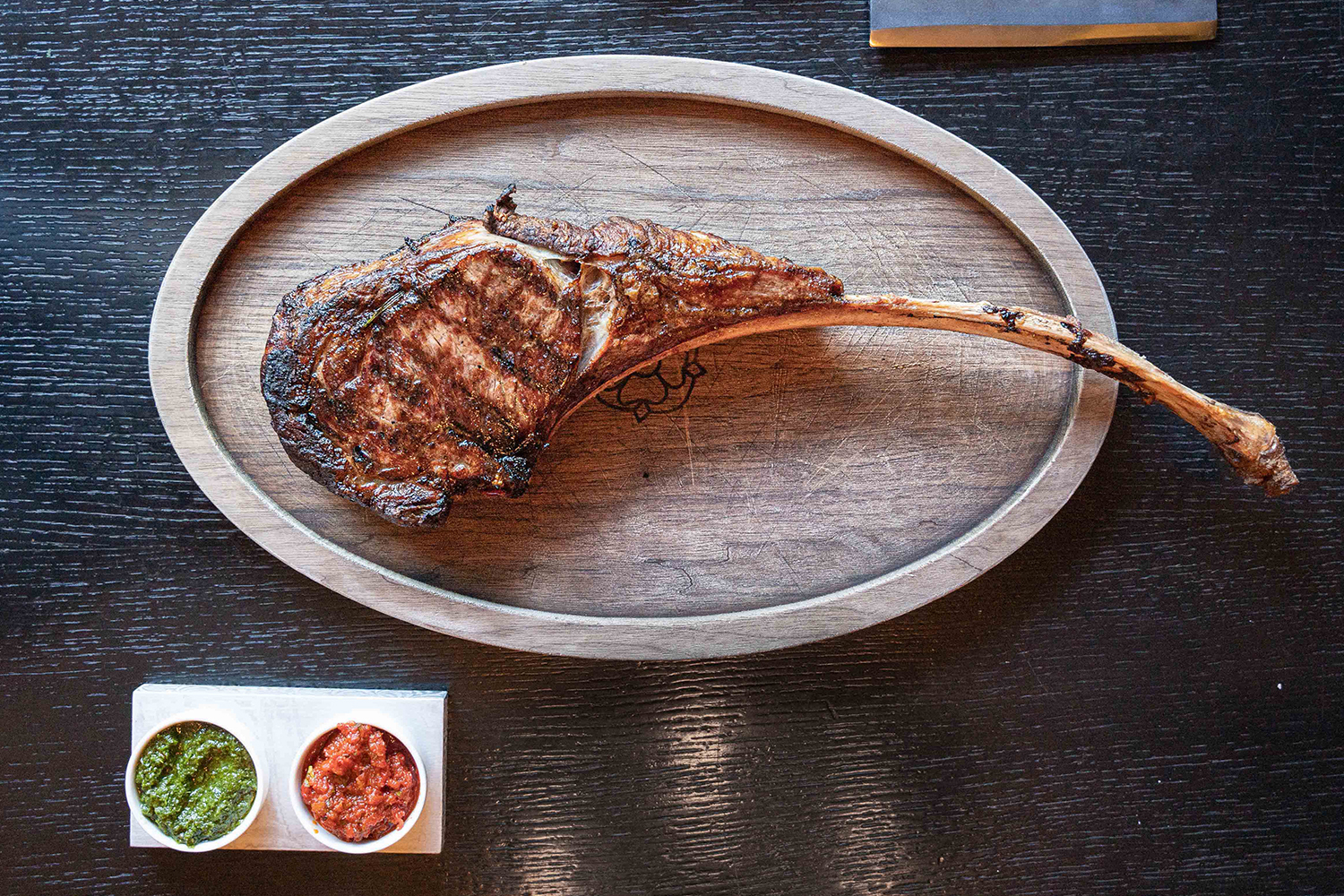
Tomahawk Ribeye Steaks with Chimichurri Sauce
Ingredients
For the chimichurri
- 3 cups flat-leaf parsley leaves (no stems!), from about 3 bunches, very finely chopped
- 6 garlic cloves, very finely chopped
- 1 ½ tsps. finely chopped fresh oregano leaves
- ¼ cup distilled white vinegar
- 1 tsp. kosher salt
- 1 tsp. freshly ground black pepper
- ¾ tsp. dried red pepper flakes
- 1 bay leaf
- ¾ cup extra-virgin olive oil
For the meat butter
- 3 lbs. trimmed beef fat, diced
- 4 garlic cloves, finely chopped
- Salt to taste
For the steaks
- 2 (48-oz.) tomahawk ribeye steaks (Manion uses Creekstone Farms dry-aged prime beef)
- Kosher salt, as needed
- Freshly cracked black pepper, as needed
- ½ cup meat butter
- Rosemary sprigs
Equipment
- Asado cross or 60-inch iron tripod
- Cinder block (optional)
- Dry kindling
- 30 lbs. split hardwood, preferably white oak
- Newspaper
- Vegetable oil as needed
- Fanning device, such as a ripped square of cardboard
- Lump charcoal
- 2 3-ft. lengths of stainless-steel wire
- Drill with a bit large enough for your wire to fit through
- Heatproof gloves, like leather welding gloves
- Tongs
- Shovel or rake
- Digital probe thermometer
Directions
1. Make the chimichurri. In a medium, airtight container, stir together the parsley, garlic, oregano, vinegar, salt, black pepper, bay leaf and red pepper flakes. Stir in the olive oil, cover and refrigerate overnight.
2. Make the meat butter. Cut the fat into very small pieces, place it in a food processor and pulse until it is the consistency of hamburger meat. Transfer to a Dutch oven and slowly cook over very low heat, stirring occasionally and taking care not to burn it, skimming any impurities that rise to the top, until it looks like crumbs and you have a good amount of golden liquid, about 3 to 4 hours. Strain the fat through a cheesecloth, then transfer it to a container. Chill until semi-soft, then add the garlic and season to taste with salt. Whip with a stand or handheld mixer for 2 minutes. The meat butter will keep for up to a month, covered, in the fridge.
3. Build the fire. First, figure out which way the wind is blowing. You can seriously just lick your thumb and stick it in the air the way they do in the movies. Set up the center brace of the asado cross or the center of the iron tripod about a foot downwind of where the flames will be. Don’t stress about this too much; you’ll need to move it into place once your fire is lit anyway. If you are using an asado cross, drive it directly into the ground, at a roughly 65-degree angle. You can secure the asado cross once you start cooking by sticking it into the hole of a cinder block.
4. Start the fire. Gather a little dry kindling and stack hardwood logs in a cross-hatch pattern to make a 10-inch square, building it three levels high. Place the kindling in the center. Drizzle the newspaper with a little vegetable oil and light it to fuel the initial burn. Fan the flames furiously with a cardboard square. Add more wood or charcoal as needed to keep the fire going at a steady blaze for at least 15 minutes before you start cooking. It should look like a proper campfire and produce a decent amount of smoke.
5. Use a drill to put a hole in each tomahawk bone about an inch from the end. Season the meat on both sides with salt and pepper. Run each piece of wire through the hole in each ribeye bone, creating a small loop around the bone. Twist the wire around itself on one end to secure it. Wearing your heatproof gloves, loop the other end of the wire around the S hook on your asado cross or tripod, adjusting the length of the wire to ensure that the bottom of the steaks are at least 8 inches from the top of the flames. Twist the other end to secure it. You might need to move it a bit; your goal is to make sure both steaks are evenly surrounded by smoke.
6. If the wind shifts again after your steaks start smoking, move the fire, not the tripod. Use the shovel or rake to push the whole burning pile in one go, again making sure the steaks are enveloped in smoke.
7. Every 30 minutes or so, use your tongs to rotate the steaks 90 degrees to ensure the heat and smoke are always evenly distributed over the entire surface. Use the rosemary sprigs to baste the steaks occasionally with meat butter. (Note: the rosemary serves a minimal aromatic function, but is guaranteed to make you look fucking cool.)
8. After about 45 minutes, start checking the temperature of the meat at the thickest part next to the bone with a digital thermometer.
9. Once the steaks reach 100 degrees, remove them from the heat. Remove the wire from the bone, and let them rest.
10. Add more charcoal if needed to make sure you have enough surface area to sear the steaks, and heat until coals have turned completely white, about 15 minutes; you want to see embers, not flames here. Using a shovel or rake, create an even bed with the coals. Fan your coals furiously to blow away any excess ash. (If you prefer your steaks grill marked, you can lay a grill grate directly over the coals; let it heat up for 15 minutes before adding the steaks.)
11. Wrap each tomahawk bone in foil to protect it from scorching (optional), and set the steaks directly onto the coals.
12. Sear the steaks for 3 minutes on each side, cooking until they are richly caramelized and the internal temperature has reached 120 to 125 degrees for rare. As you turn the steaks, brush off any coals that stick to the meat.
13. Remove the steaks from the coals and allow the meat to rest, uncovered, for at least 5 minutes. Baste the steaks with liberal amounts of meat butter while they rest.
14. Slice each steak along the bone to remove the ribeye. Carve against the grain into thick slices. Enjoy.
15. To put out your fire: Let it burn down until it’s almost entirely ash, then with your rake, turn the ash over a few times, smothering it with dirt and pebbles. Don’t pour water on it. It will make the ash into mud, which will make cement.
This article was featured in the InsideHook Chicago newsletter. Sign up now for more from the Windy City.
